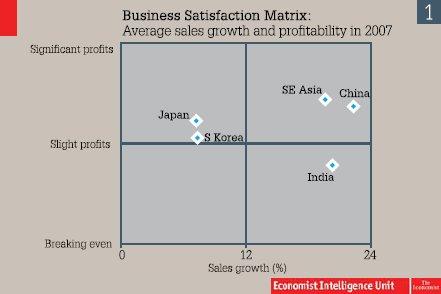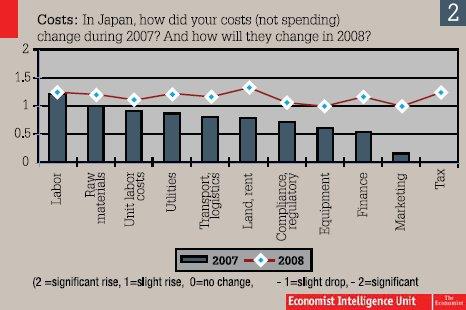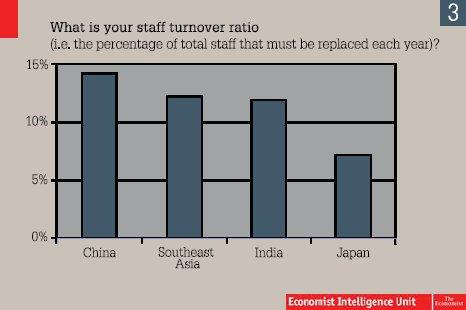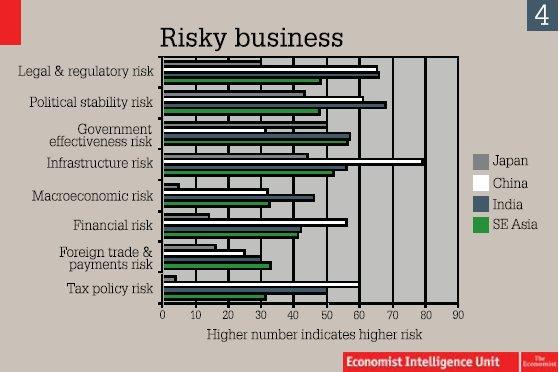The Long Game
Graham Davis, Director of the Economist Intelligence Unit (EIU) in Japan considers the conditions for foreign businesses in Japan based on EIU surveys and research
It is a marathon, not a sprint. And that might be just as well given the problems company heads seem to face in running their businesses in Japan. Whether foreign or domestic, the challenges of slowing sales, rising costs and turbulent hiring conditions would be enough to make any executive lose sleep. But for the executive at a foreign company in Japan there is an added layer of difficulty—just how committed is your company to the country?
It is easy to understand why company headquarters in far away parts of the world lack enthusiasm. Ferocious local competition, largely static markets, difficult business practices and a general lack of integration in the international community make Japan appear unattractive relative to the perceived opportunities in China, India and the rest of Asia. Offer headquarters a billion customers and 10% annual growth and watch them drool.
So should we expect an exodus of foreign companies as things turn down in Japan? Are Vodafone, Carrefour, Boots and other such blasts from the past going to be followed by other companies who find it all, well, too difficult?
I think not. I think that secretly many foreign companies are actually rather pleased with their activities here. Don’t shout about it, but Japan is actually a profitable and important market for many.

The Economist Intelligence Unit Corporate Network surveys annually our members across Asia about business conditions, prospects and risks. The results for Japan for the last survey, conducted in December 2007, are a combination of the usual gloom and whinges about rising costs, staffing challenges and a slowing economy (well, management has to justify its existence somehow I suppose) and relative satisfaction at actual performance and profitability. And if management thinks it has challenges here, they are dwarfed by what companies face elsewhere. Japan as a cushy number—who would have thought it? (see graph 1)
No surprise of course that Japan is a low growth market. And in fact, most respondents expect things to slow here in 2008. But what is impressive is that across a whole range of business areas—from commodities to chemicals, from property to professional services, from mall to manufacturing—people make money. And think about that growth position—our respondents on average achieved sales growth in the order of 7% in 2007, impressive in an economy struggling to achieve 2% growth.
Headquarters of course is slobbering now at the growth and profitability figure for China— a great combination of good profits and quick growth. And having ignored Southeast Asia since the Asian crisis 10 years ago, companies will be wondering whether that area too is an alluring combination of growth and profitability. India too has that crucial selling point of being an underexploited market of over a billion people—so why not just ignore the fact that profitability is low and hope that eventually it will come good. After all, for many, India is a relatively new market so optimism on future profitability is probably not unreasonable.

But back to the mature and supposedly difficult market of Japan—firstly, costs (see graph 2). Things might seem tough here—it looks as though across the board, costs are expected to be higher than 2007, and respondents seem most concerned about land and rent costs in 2008.
But tough is relative. The numbers for Japan are dwarfed by cost expectations in China and India. Take Labor. Our survey showed management in Japan dealing with management and skilled labor cost increases of 5-6% a year in 2007. The figures for both China and India are around double that—with major skill shortages emerging in a number of key areas. Multinationals in India for example are now getting used to paying hiring bonuses—previously a rare recruitment tactic. Sales professionals, branding experts and promotional activities are all becoming major cost challenges for businesses in India—while in China it is not just a question of rapidly rising costs but quality is also a major headache.

The biggest difference though lies in staff turnover—and here the difference is striking. (see graph 3)
Japan is the only location in the region where staff loyalty translates into a stable workforce where management is not under continual pressure to fill gaps, let alone grow. Imagine the challenge of running a business in the services industry in India, where annual staff turnover approaches 35%; how do you expect customer loyalty when you don’t even get it from your own staff? Or look at China and the 10% rise in unskilled labor costs per annum—they might be rising from a very low base, but that is some wage inflation, and for unskilled labor by far the highest in the region. No, you might actually be better off in slow growing, slow changing Japan.
So it is profitable, if a bit boring if you like a staffing challenge. Is it all going to go wrong though—does business in Japan have greater threats to its survival than elsewhere? Could the government continue its destructive policies which in recent years have brought ruin to the consumer finance and housing industries?
Well, the government clearly has some talent in that direction. But overall Japan represents a fairly benign risk environment: despite its appetite for destruction, Japan offers a much better regulatory and legal risk environment than China or India. While we might moan about political stagnation and inaction in Japan, it is stable stagnation, even if toothless in the ability to deal with problems. Nor does Japan have anything like India’s infrastructure problems, China’s tax policy risk—and a stable but slow economy is much less risky than either of China or India’s high growth—high opportunity economies. (see graph 4)
 All graphs and data provided by The Economist Intelligence Unit
All graphs and data provided by The Economist Intelligence Unit
So sensible multinational businesses will see Japan for what it is—an important market where profits are hard earned but achievable. An attractive market which might not have the complete allure of China and India these days but which certainly doesn’t have their challenges and risks either. A marathon, not a sprint, with some pretty satisfied people out there quietly getting on with it.
About the survey
Each year, The Economist Intelligence Unit Corporate Network conducts a survey of its members. The idea is to build up a picture of what businesses think about Asia. How are companies performing? Which markets are doing well? Which sectors? What are the big business challenges and how are companies tackling them?
The survey was carried out in December 2007. All 600 member companies of our Corporate Network service in Asia—which runs in Singapore, Hong Kong, Tokyo, Shanghai and Beijing—were invited to take part.
A total of 259 respondents completed the survey, with an even spread across all five cities. Respondents were all senior executives, many of them with overall responsibility for the Asia Pacific region.
The majority of respondents came from Western multinational companies, 83% of the total. The remaining 17% were Asian companies.
On the whole, respondents worked for large companies; 71% had global revenues of more than US$1 billion.





